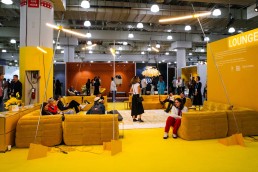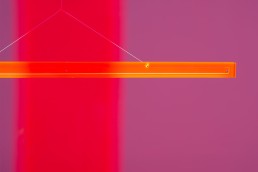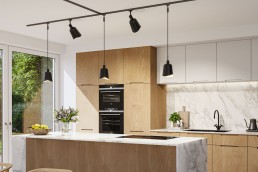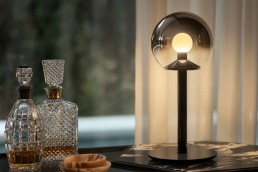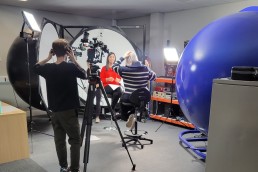ICFF
For this edition, the thematic focus is “Designing in Harmony,” emphasising human-centred, multi-sensory, and multicultural design that reflects the diversity and dynamism of the global industry and the world at large. This approach underscores craftsmanship, sustainability, and the human connection at the heart of design, creating an environment that fosters genuine connection, sparks creativity, and celebrates innovation. With immersive exhibits, engaging discussions, and strategic networking opportunities, ICFF is where the design community converges to explore new ideas and shape the future of design.
At North America's leading platform for contemporary furnishings, experience:
- 450+ global brands from over 35 countries presenting the latest in high-end furniture, lighting, textiles, flooring, and materials for residential, contract, and hospitality settings.
- Thought-provoking insights through ICFF Talks—engaging panel discussions, keynote presentations, and exclusive conversations led by industry visionaries, trendsetters, and design experts.
- Unparalleled networking opportunities with over 10,000 architects, interior designers, retailers, distributors, developers, and media professionals, creating valuable connections to propel business and creativity forward.
- First-hand exposure to emerging trends, sustainable solutions, and forward-thinking designs that are defining the future of the industry.
From groundbreaking product launches to meaningful conversations with top professionals, ICFF is where design visionaries gather to inspire and be inspired. Explore fresh ideas and innovative materials and immerse yourself in the forefront of design excellence.
Date: 18-20 May
Location: Javits Centre, New York
For free access use our promo code: DAPMDARC
[d]arc sessions Asia
For specifiers and suppliers of international lighting projects; [d]arc sessions is an intimate, relaxed space to share ideas, specify projects and network. Curated by [d]arc media, the two-day programme comprises a series of meetings and seminars interspersed with ample networking opportunities within beautiful surroundings.[d]arc sessions is a series of events connecting the very best people creating exceptional lighting projects around the world.
It takes place twice a year (once in Europe and once in the Middle East or South East Asia) and comprises four key elements: Speed+Sync meetings; Symposia speaker sessions; Sustenance breakouts; and Social celebrations. Guests attend [d]arc sessions to specify and source projects; to escape, regenerate and rebuild, in beautiful, spacious surroundings.
To get involved in the next edition of [d]arc sessions, head to: www.darcsessions.com
Maison & Objet Highlights 2024
Maison & Objet, the major French trade fair for interior design returned for its bi-annual appearance at the Paris Nord Villepinte Expedition this January. darc’s Web Content Creator Ellie Walton attended the show to marvel and discover the latest and greatest the show had to offer from the lighting industry. Amid her exploration, she encountered a captivating mix of new and familiar products, each leaving an impression through their geometric and abstract shapes, illusive use of light refractions or simply show-stopping design. Dive in to what caught darc’s curiosity in our Maison & Objet 2024 highlights below.
Endless wall lamp by Design By Us
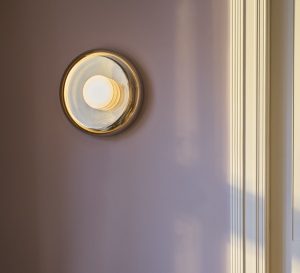 This is not your ordinary wall lamp, its sleek, its function-able and mysterious. The Endless wall lamp transcends the ordinary with a front adorned with a reflective mirror that fades away when turned on. Precise and contemporary, its alluring design can fit into an interior space to give a touch of glamour while simultaneously creating a sense of space and airiness with its reflective mirror. This lamp is universal as a standalone fixture or an ensemble. Ideal for restaurants, hotels, showrooms, or for the home in bedrooms, hallways and even bathrooms.
This is not your ordinary wall lamp, its sleek, its function-able and mysterious. The Endless wall lamp transcends the ordinary with a front adorned with a reflective mirror that fades away when turned on. Precise and contemporary, its alluring design can fit into an interior space to give a touch of glamour while simultaneously creating a sense of space and airiness with its reflective mirror. This lamp is universal as a standalone fixture or an ensemble. Ideal for restaurants, hotels, showrooms, or for the home in bedrooms, hallways and even bathrooms.
Applique B206 wall sconce by Michael Buffet
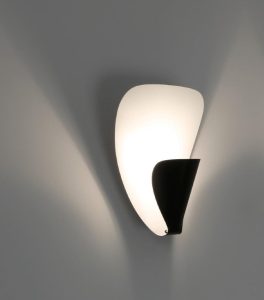 Created in 1953 by designer Michael Buffet, this sconce is part of the re-edition collection with Disderot, celebrating 1950’s to 1970’s French design. This unique lamp with abstract geometric shapes has proven to stand the test of time, perhaps even been before its time, with a sleek contemporary finish perfect for minimalist styles looking for an edge. Ideal for bedrooms, hallways and as reading lamps.
Created in 1953 by designer Michael Buffet, this sconce is part of the re-edition collection with Disderot, celebrating 1950’s to 1970’s French design. This unique lamp with abstract geometric shapes has proven to stand the test of time, perhaps even been before its time, with a sleek contemporary finish perfect for minimalist styles looking for an edge. Ideal for bedrooms, hallways and as reading lamps.
Mezzaluna by Bruno Gecchelin
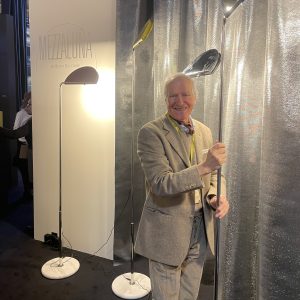 Another re-edition vintage piece brought the show by DCWeditions alongside the designer himself, Bruno Gecchelin. Made in 1974, and produced by Skipper and Pollux in Milano, the floor lamp has a chrome plated tubular structure, a white marble base, and a black-enamelled head that adjusts to suit. This would be a sleek vintage piece to work as a reading lamp in living rooms, home libraries and offices.
Another re-edition vintage piece brought the show by DCWeditions alongside the designer himself, Bruno Gecchelin. Made in 1974, and produced by Skipper and Pollux in Milano, the floor lamp has a chrome plated tubular structure, a white marble base, and a black-enamelled head that adjusts to suit. This would be a sleek vintage piece to work as a reading lamp in living rooms, home libraries and offices.
Focus by Yuji Okitu
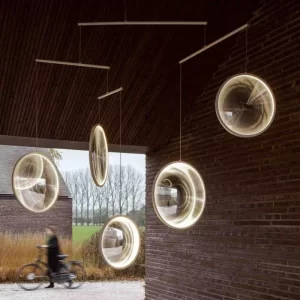 The Focus pendant is designed by Tokyo-based architect Yuji Okitsu who has a unique sensibility across fields of architecture, design, and art. DCWeditions displayed the light that suspended similarly to a mobile structure so that the bubble-like pendants floated elegantly. Each luminous disc is made of acrylic glass and provides illumination through Fresnel lenses that focus and refract light. The Focus lamp has a flexible aluminium base available in black or white. This pendant lamp is available with three lenses, Focus x3 to Focus x 5, with a span of 99.8cm to 160.8cm, this airy light can create a sense of tranquillity in any room.
The Focus pendant is designed by Tokyo-based architect Yuji Okitsu who has a unique sensibility across fields of architecture, design, and art. DCWeditions displayed the light that suspended similarly to a mobile structure so that the bubble-like pendants floated elegantly. Each luminous disc is made of acrylic glass and provides illumination through Fresnel lenses that focus and refract light. The Focus lamp has a flexible aluminium base available in black or white. This pendant lamp is available with three lenses, Focus x3 to Focus x 5, with a span of 99.8cm to 160.8cm, this airy light can create a sense of tranquillity in any room.
Lamina by Sandra Peters
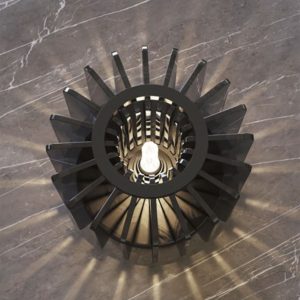 Lamina comes from the By Eve Black collection of luxurious and extremely refined lighting designs and works of art. The Lamina is made of vertical discs of dark coloured glass with a round wooden base; light seeps out between the discs of glass leaving a fascinating play of light and various shadows through the laminas. The composition of dark and light the Lamina creates makes it a great atmospheric piece for relaxing settings in the evening. There are two available sizes for the Lamina, one 29cm x 20cm or 21cm x 40cm.
Lamina comes from the By Eve Black collection of luxurious and extremely refined lighting designs and works of art. The Lamina is made of vertical discs of dark coloured glass with a round wooden base; light seeps out between the discs of glass leaving a fascinating play of light and various shadows through the laminas. The composition of dark and light the Lamina creates makes it a great atmospheric piece for relaxing settings in the evening. There are two available sizes for the Lamina, one 29cm x 20cm or 21cm x 40cm.
Maison & Objet Sustainable Standouts in Lighting
During Maison & Objet this January, darc’s online content creator Ellie Walton sought-out the purpose driven creators that are crafting products that blend opulence with durability as well as leaving a positive impact on our planet. Read on to discover her findings.
Sustainable designers are the vanguards that are leading the charge of the transformative change the industry needs. These designers aren’t just redefining longevity but also championing progressive production methods and innovative material applications.
During my time at the Paris-based fair, I found products that won’t just live a lifetime but can also live a life, one that is born and then dies through biodegradable properties. The following designers are those I found leveraging their platform and brand to embrace sustainable design, from the use of recycled materials to the treatment of garment workers. In the lighting industry, these visionaries are wielding their power of design to shape consumer habits, fostering an environment where conscious consumerism can truly flourish.
Originalhome’s Bottle Cap Lamps
Originalhome’s commitment to sustainability is evident in its design philosophy, effortlessly infusing a cool and laid-back vibe into any space. The rattan-style lamps stood out offering a touch of shabby-chic bohemian elegance that boasts an aesthetic that withstands time.
These rattan looking lamps are crafted with a unique twist – recycled bottle caps taken from the coastlines and rivers of Indonesia. Speaking to the designer said “Normally people use the bottom of the bottle because they’re easy to use and transparent. The Bottle caps, however, are lot harder to use and recycle, so we found a way to recycle them. The downside, or perhaps upside, is that the lamps can only be available in green, blue, or brown.”Using the harder pieces of plastics allows the lamps to be stronger and more durable, making them suitable for both indoor and outdoor environments. 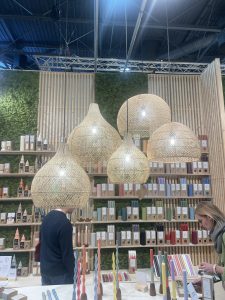
The company’s dedication to sustainability extends beyond the product itself. Each item is meticulously handcrafted, and the only machine used in production is for the recycling process of the bottle caps. The company also calculate the CO2 emissions through the entire production and distribution process in which it proportionally gives back through initiatives like planting trees and providing cooking stoves to women in India. Originalhome understands that we live in a world where conscious consumer choices matter and offers products for style and impact.
N-Lobjoy Porcelain Paper shades
Nathanaëlle Lobjoy, artist and craftsman, seamlessly blends poetry into decoration through her exquisite paper lights, crafted and plant-based materials sourced from Europe. Employing a combination of pencil, pen or even brush, Lobjoy intricately creates floral and plant-inspired designs, which are artfully printed onto the lamp shade. The shades themselves are fashioned using a papier-mâché technique, showcasing Lobjoy’s unique modelling and craftmanship that imparts the illusion that the lamps are biscuit porcelain – a traditional European un-glazed, matte porcelain finish.
She tells me that the underlying concept of her designs is to create functionable products that are like hanging art by day then lights by night.
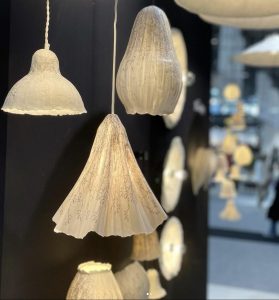
In a transformative journey spanning 30 years, Lobjoy transitioned from using chemically harmful and unsustainable materials. Seven years ago, she committed to minimising her use of harmful chemical materials and contribution to landfill. Expressing her stance, Lobjoy says: “I don’t believe it’s necessary and I do not want to contribute adding more dust into the world. For the decoration I chose paper because it takes less energy, and it removes the need to use other chemicals and products like polish. The only manufacturing energy comes from my hands to transform the pieces.”
The environmentally conscious approach also extends to the recyclability and biodegradability of Lobjoy’s paper lamps shades. As they are crafted from paper, the shades can be completely recycled thus creating more recyclable paper, which becomes more accessible and re-useable. Ultimately, this ensures Lobjoy’s materials are abundant for her continued creations with unique patterns.
Let’s Pause “Leather” lamps
Nestled in hall 8 of Maison was the brand Let’s Pause, a company that is rooted in its sustainable philosophy and creating synergy between design and nature. Among its showcased products was the extraordinary lamp shade known as ‘Couro’, which translates from Portuguese to mean “leather”. Contrary to its appearance, the material may look like leather but is in fact derived from the leaf of a palm tree, which the brand will only harvest when the tree has blossomed and shed its leaves to the ground. The leaves are then steamed to attain flexibility and take shape using only sewing – a simple handmade process that doesn’t use any machine-powered energy.
The visual resemblance to leather, coupled with a tactile sensation, creates a trompe l’oeil effect through its stretchy and flexible leather texture. 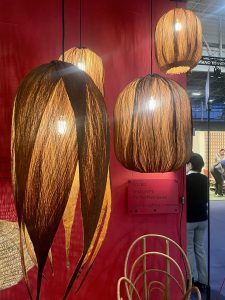
Also, not only does the shade’s appearance mimic leather but it equally matches its durability. Let’s Pause boasted at the show that the shade has a perpetual lifespan. However, if the customer desires a change or to dispose of the product it can simply be removed and recycled back into nature through decomposing the material. Its versatile nature makes it equally suitable for home decoration or illuminating counter tops and bars in a hospitality setting, embodying a philosophy that seamlessly fuses ecological consciousness with modern chic.
Ay Illuminate Continental Lanterns
On the way out of Hall 8 it was hard not to be stopped by the stunning display of Asian Lantern-inspired shades. Suspended gracefully over a stone bench was the Z Series, a creation by conscientious brand Ay Illuminate, with its captivating zen-like arrangement. The meticulous craftmanship and unique array of material could compel anyone to stop and appreciate the artistry.
The Z Series lanterns are offered in three sizes, each featuring covers crafted from a diverse array of materials sourced from various countries including Afghanistan, Senegal, and the Philippines. Each lamp is unique as a result of its hand-crafted production and the various materials available for the covers such as cotton, cashmere, sisal netting and carboard. The neutral and dark shades emanate from the material itself or from the use of natural ingredients such as tea.
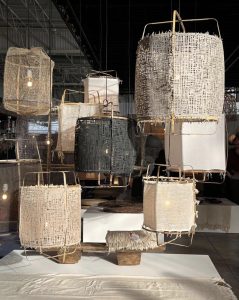
Notably the framework of the lantern is composed entirely of bamboo. Designer of the Z Series, Ay Lin Heiner, says: “We use bamboo because its strong and looks clean but is also completely sustainable. Bamboo is like grass; you can cut off branches and it will quickly grow back as well being completely biodegradable.”
Ay Illuminate maintains a commitment to sustainability by having the lanterns crafted in the same location as the cover’s material is sourced. According to Heiner, the brand works with villages to provide jobs for the locals and focuses on providing opportunities for women and girls to learn craft and new languages such as English, fostering their independence.
The use of natural materials in the pendant lamps makes it an ideal choice for home décor, restaurants, and bars for those aiming to showcase a blend of opulence and authentic spirit.
A new chapter for ICFF
(USA) – New York-based International Contemporary Furniture Fair (ICFF) celebrates its 35th anniversary with a new direction for the show.
The ICFF team is reshaping the core of its brand to remain one of the leading contemporary design fairs. Its aim is to solidify its position as the entry point to the U.S. market for international brands, clarify its objective to be at the centre of culture, community and commerce and be appealing to the next generation, plus amplify content year-round to support design brands.
As part of the translation of its new vision, a new identity for the show has been created by New York-based creative agency forceMAJEURE. The new aesthetic features a solid, heavy wordmark reminiscent of the densely populated New York City, which is juxtaposed with a lighter typeface.
“New York City is substantial, to say the least. The density, scale, and span of the buildings have a way of making you feel small and empowered at the same time. New York City’s famous grid was created to combine beauty, order, and convenience. Today, the grid is so famous that it has inspired branding for the city itself, making it recognizable on a global scale. Our design work within this rectangular framework brings a million possibilities for unique expression that speaks to spatial design and is very much a tribute to the spirit of New York,” states the forceMAJEURE Design Team.
ICFF will tap into the expertise of RADS, Rodolfo Agrella Design Studio, to implement the new branding into the show floor and create the 2024 look and feel for the fair. This will include the talks on the Mainstage and The Oasis; the Wanted Lounge; The Restaurant; and the Fair’s overall wayfinding aesthetic.
Official branding will be unveiled sometime this month.
“Given ICFF’s 35-year history, we felt it was time to redefine and rebrand ICFF to solidify, clarify, and amplify our design messaging and content. Since ICFF is the leading contemporary design fair in the U.S., we decided to concentrate on the most important products, technologies, and issues facing the industry and partner with global, high-quality brands that reflect ICFF’s ethos. Our long-standing collaborations with the industry increase our engagement year-round with the design community, allowing us to enhance ICFF’s brand visibility across design communities around the world,” says ICFF Brand Directors Odile Hainaut and Claire Pijoulat.
As part of its continued focus on sustainability, ICFF is making changes to decrease the show’s carbon footprint and lessen the amount of waste it produces. Efforts include removing most of the carpet from the show floor, renting walls instead of building them, using recyclable material for all signage, placing water fountains throughout the floor for refillable bottles, using low-energy lights, and asking the food vendors to avoid single-use plastic. It is also encouraging all participants to follow its lead and do what they can to lessen their carbon footprint at the fair.
With the ICFF Talks on the Mainstage and The Oasis, the main programming topics for the fair this year include:
- Sustainability and materials
- The best in making and producing, from hand-made and high-end craft to new industrial innovations and technology-related processes.
- Business and collaboration opportunities in the U.S.: how to achieve company goals, understanding the U.S. market better, design landscape, and needs.
- Education, including diversity in design, original design, and new tools (AI)
Further new additions to the show include a more curated, accessible, and user-friendly experience. The show floor will include more spaces to explore, lounge, network, and have conversations. New dedicated areas have been created for complementary products such as Materials, Outdoor Living, and Kitchen & Bath. The latter will also feature a lounge area for dedicated programming. The newly designed spaces will offer activation and communication opportunities for attendees, including Bespoke: The Art of Making; Design School Workshop presented with media partner Core77 and conducted with Pratt Institute and Honda R&D Co., Ltd. Honda Design; ROOM + OFS Podcast Studio; and The Library in partnership with Phaidon.
Dedicated to emerging design, WantedDesign returns as a centrepiece of ICFF with Look Book, Launch Pad, the Schools Showcase, and the new Design Schools Workshop.
Returning this year at the heart of the fair, The Crossroads will be a collaboration between the ICFF brand directors; Creative Director David Rockwell, founder of Rockwell Group; and co-curator and editor Pei-Ru Keh. Sustainability, in its complex and multifaceted form, serves as the focal point of The Crossroads’ second iteration. This year’s exhibition will spotlight the way designers seek to preserve long-honored craft traditions, together with how they push the boundaries of circularity to consciously re-think the legitimacy of material use. It will also highlight the different ways creative communities can make design more accessible to all, whether through more inclusive cultural representations or deeper community-wide engagement.
Programming curator Tiffany Jow, Editor-in-Chief of Untapped, will develop and host talks at The Crossroads with Pei-Ru Keh.
The core talks will occur on the Mainstage and The Oasis space. The Mainstage is sponsored by Turf. Additionally, focused conversations will take place in new dedicated spaces such as Bespoke, Crossroads, Look Book with media partner Dezeen, and Kitchen + Bath.
The Oasis will continue to host conversations about sustainability and conscious design topics. The Welcome Lounge, The Restaurant, the ICFF Editors Awards, and other features will also return.
Many country groups from around the world are joining ICFF in 2024 for the International Pavilions, including Norway, Brazil, Portugal, and Romania to name a few.
ICFF is evolving beyond the fair to promote its partners year-round through expanded editorial content and programming, networking, and promotional opportunities. Throughout the year, it will amplify partner and exhibitor materials across its channels (digital, newsletters, social media) and support events such as showroom activations and partnered programs to engage and educate the design community. Plans for 2024 include a networking opportunity in Paris in January, a global virtual press preview in February, a Look Book talk in NYC in April with media partner Dezeen, an event in Milan in April, and a networking designers’ trip to Design Week Mexico in October.
“Rather than ICFF being just a three-day event, we are building a brand to speak to the design community 365 days a year, on all platforms. We want to keep the conversation going and continue to provide relevant stories for the entire design spectrum from students and emerging designers to more established designers and architects. We are promoting all through our channels to make it a real added support to the industry,” says ICFF Brand Directors Odile Hainaut and Claire Pijoulat.
The next edition of the fair takes place May 19-21, 2024, at the Jacob K. Javits Convention Center, New York.
In Conversation - Lights on Screen - Glass Onion
In issue #51 our editor Sarah made a fascinating series on where she uncovers the products and people of the lighting industry that have found themselves working in the movie industry. In November 2023 Sarah speaks to set designer John Mchughes and Qusaur founder Arjens Van Gammeren and their collaboration on Netflix's hit movie 'Knives Out: Glass Onion' where the Qusaur chandlier was featured in the iconic dining table scene.
Tonone to launch new Bridge lamp
(Netherlands) – Tonone is soon to launch a new product to its collection, Bridge, a lamp that allows for graphic interplay of lines and various compositions that have taken inspiration from the construction of bridges.Like the real architectural structure, Bridge has different supports, so that the load-bearing capacity is evenly distributed along its length. Avoiding the use of power cables, electricity is conducted by steel cables, which are also used to hang the lamp.
This design lamp is made of recycled plexiglass and is available in two neon colours and in an opal colour. The transparency of the material creates an interesting layering and impressive light output. The three colour variations available are: Fog White, Lava Orange and Toxic Green. In addition, the lamp is available in different lengths: 110, 150, 180 and 220cm. Due to the choice of length and colour, Bridge is a versatile fixture suitable for various environments.
Bridge is – like all other Tonone lamps – an original Dutch design by Founder Anton de Groof, who has been creating functional lighting designs since 2008 by combining mechanics and traditional tools. Together with local specialists, the Tonone team is continuously working on making the design and production process more sustainable.
Artist Stefano Colferai creates stop-motion series with Foscarini
(Italy) – Milanese artist Stefano Colferai callborated with Foscarini in an animated stop-motion series exploring the relationship between light, lamps, individuals, and the home.
In his series for Foscarini's "What's in a Lamp?", Colferai was inspired by another editorial project from the brand: VITE by Foscarini and Gianluca Vassallo, which demonstrates the emotion and atmosphere a Foscarini fixture can bring into the home.
The two created an animated series in which the brand’s lamps seamlessly integrate into the daily life of a friendly plasticine character throughout the day, from morning breakfast to evening binge-watching TV while accompanied by the light and form of the lamps in different rooms.
The collaboration between Colferai and Foscarni occurred through a shared interest on light, attention, an appreciation for form and craftmanship. Colferai said: “I found Foscarini's VITE project fascinating from the start, depicting the relationship between light and lamp, person, and home through photography. It was greatly inspiring for me to capture imperfections in the shots of these narratives where light is abundant, attempting to question how the relationship between a person and their home has changed over the years."

Colferai adds: “The character experiences his daily routine accompanied by the light and form of the lamps in different rooms, preserving the language that characterises my artistic style with the same spontaneity as the VITE stories.”
Colfarai also discussed how light plays a role in his art, he said: “[It] is fundamental: my works wouldn't exist without photography! While there’s consistency in the lighting of my works, I've conducted extensive research over the years to find the best relationship between my subjects, set, surroundings, and lighting, attempting to construct narrative through light. Communicating through photos and videos, the right light can significantly enhance a sculpted piece and frames arranged in sequence to create an animation, establishing the proper atmosphere, and defining the body and character of each scene. Studying the light in every animation or still frame is one of the moments I invest the most time in, along with modelling.”
To watch the Foscarini stop-motion clips visit @foscarinilamps on instagram
Home & Lifestyle Show Previews
(UK) – The highly anticipated inaugural Home & Lifestyle Show (H&L Show) is only a month away. We’ve created a preview list of product highlights to kickstart your visitor plan.
The H&L Show will take place at the January Furniture show on 21 – 24 January 2024 at the NEC Birmingham, the H&L Show offers visitors the opportunity to explore lighting, furniture, homewares, upholstery, and lifestyle.
H&L Show is marketplace for interior designers and retailers to seek the new season’s product offering, as well as see the latest launches and designs hitting the market. The show will include an array of lighting brands including: Dannells, Gallery Direct, Mindy Brownes Interiors/Genesis Fine Arts Limited, Paulmann Licht, Premier Housewares, and more.
Below is a curated list of some the exciting products some of these brands have to offer:
Finishing Touches Bedroom Table Lamp
Finishing Touches' effortlessly sophisticated bedside lamp’s design embodies refined taste and opulence, creating a product where functionality meets sophistication. Finishing Touches is the perfect brand for those looking to mix artistry and furnishings in a creative way.
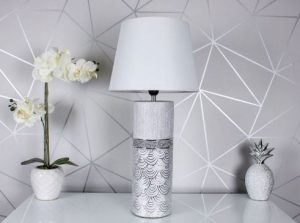
Dannells Lampshade Making Kits
Dannells’ Professional Lampshade Making kits give designer-makers the power to create their own 70cm and 15cm lampshades with 13 styles to choose from. These professional kits allow design-makers to create stylish and bespoke lampshades for their clients from their own choice of fabric and paper.
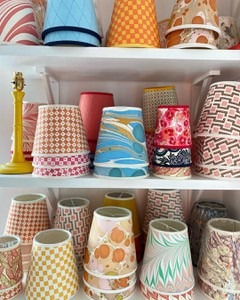
Paulmann URail rail and Corduo cable system
URail rail and Corduo cable systems are suitable for both residential and commercial spaces. Paulmann’s focus on innovative lighting systems is unparalleled and the URail rail and Corduo cable systems are designed for function-forward lighting solutions, allowing light to be freely distributed throughout the entire room, regardless of the position of the power supply.
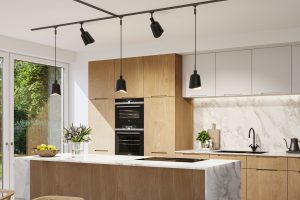
Kelston House International Metal and Marble Floor Lamp
By blending a mix of modern design and grandeur, Kelston House International has created a floor lamp that doubles as a sculptural centrepiece. The lamp’s visual blends contemporary aesthetics with a choice of marble. This piece is perfect for living spaces adding a touch of grace and poise to understand decor without being overpowering.
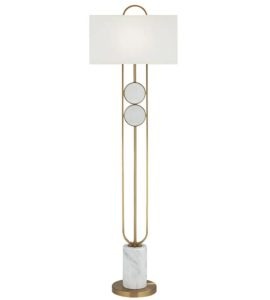
Premier Housewares Wyra Champagne Gold Frame Pendant Light
If you’re looking for up-and-coming trends, the geometric iron frame shade piece, due to its modern slender design and champagne gold finish. This pendant light creates a captivating play of light and shadow that looks splendid on its own or with accompanying lights hung at different heights. Perfect for those looking for a luxe aesthetic.
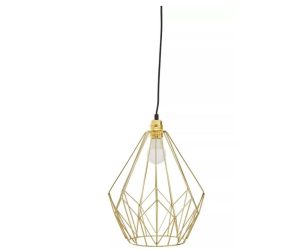
Paulmann Plug&Shine Outdoor Lights
The Plug&Shine range is an ideal weatherproof cable system with its flexibility to be expanded, depending on the garden’s path, walkways and patio size and style. No matter the design and lighting requirements of the space, the Plug&Shine system is perfect for any sized garden or outdoor space and can be controlled with an optional controller.
The H&L Show also offers facilitated networking opportunities with the industry via, a Champagne Bar, a Show Party featuring the Furniture awards, and a Women in Furniture ‘Speed Networking’ event.
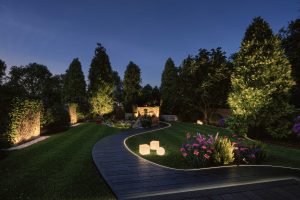
Click here to register and find out more at www.thefurnitureshows.com
[d]arc awards extend entry deadline
After being inundated with a number of requests for more time, the [d]arc awards entry window has been extended.
Now for all project, event, and product categories, there will be a new deadline of 25 January 2024 to enter submissions.
Organised in collaboration with Light Collective, the [d]arc awards utilise the worldwide reputation of arc and darc magazine, and offers a unique opportunity to showcase your work to the global design community.
Anyone can enter, including lighting designers, architects, interior designers, or manufacturers. Once the shortlist has been chosen by an international jury, independent lighting designers, architects, interior designers, and product designers can vote on their favourite projects and products, making this the only truly peer-to-peer lighting design awards in the world.
All submissions are published on the website and entrants also benefit from a free [d]arc awards directory company profile – a comprehensive online lighting design resource that can be used by designers and clients for inspiration.
The winners will be announced and aired at the [d]arc Awards party, [d]arc night, on 27 March 2024 at fabric London.
Discover more at www.darcawards.com
Occhio presents new moon-inspired lighting
(Germany) - Luxury German lighting brand Occhio presents Luna, a new series of floating, celestial-inspired glass designs that can be controlled by contact-free hand gestures.
This latest collection advances Occhio’s state-of-the-art technology and will be on display at the brand’s newly opened flagship store in Brompton, London. The collection was unveiled at London Design Festival 2023.
Luna is the first series to feature Occhio’s new patented ‘fireball’ light source, which is set within a partially mirrored glass sphere to create a soft, glare-free effect. The collection comprises wall, ceiling, table, and suspended designs, with each piece bearing metal accents available in high-gloss chrome or phantom finishes.
Fitted with Occhio’s technology, Luna can be controlled by touch free, intuitive gestures. With the move of one’s hand, the lighting can be switched on or off, dimmed, brightened, or set to a new colour temperature. An accompanying app, Occhio Air, can also adjust the setting to create a myriad of ambient lighting experiences and moods.
With its seamless shape and variety of different sizes, the collection can be playfully arranged to curate creative formations within a room. The Luna is available in four models including; the Luna Sospeso, a suspended luminaires available in three sizes and can be grouped together individually or arranged as a cloud solution with three or five luminaires for round and long tables; the Luna Piena is for ceiling designs that create a soft, directed light and available in three sizes; the Luna Parete wall luminaires that appear to float on the wall; Luna Sogno is for table luminaires.
Axel Meise, founder and designer at Occhio, said: “Luna is like from another world. Its classic shape, coupled with its stylish finishes, the magical lighting effects and its playful potential uses instantly draw people under its spell.”
Luna will be on display at Occhio’s new flagship store in Brompton, located next to the iconic Michelin House in Kensington & Chelsea.
BBC calls on expertise of The LIA for SAD lamp investigation
(UK) - The LIA Laboratory has been showcasing its breadth of expertise as Ayça Donaghy, CEO of the LIA, recently featured on the BBC’s Morning Live to discuss Seasonal Affective Disorder (SAD).
The call to The LIA Laboratory came as the BBC set out to investigate the effectiveness of SAD lamps; a common technology used to counter the effects of the disorder. Known for its technical prowess, The LIA Laboratory was selected to test the products, with Donaghy taking to our screens to present the findings.
With more than two million people in the UK suffering with SAD, it is a vital topic to raise awareness of. SAD is a form of depression that occurs during the winter months when there is less daylight. SAD presents as persistent low mood, oversleeping and overeating, with fatigue affecting sufferers in their day-to-day activities.
Medical professionals recommend a higher dose of vitamin D alongside trying to get more sunlight during the day to treat SAD. Another tool used to treat the condition is SAD lamps. These are designed to deliver a dose of light that can potentially deliver the same levels of light as being in sunlight.
With a plethora of SAD lamps on the market, ranging in price from £10 up to £300, it is difficult for consumers to know where to start. This was the driving factor behind the BBC enlisting The LIA Laboratory’s expertise to test the lamps.
Any lamp can be marketed as a SAD lamp, and there is no requirement for them to be registered as medical devices. The three lamps selected by the BBC team and scrutinised by The LIA Laboratory are not registered, so the testing on these lamps is likely to be limited in its scope. The lamps spanned three price ranges – low, middle, and high.
First, the lamps were tested for their UV output. Donaghy revealed to viewers that all of the products were risk group zero, or exempt, which meant they could not cause any damage to the end-user.
Next, The LIA Laboratory tested colour temperature. Donaghy was able to confirm that all products were in 1% of their claims, meaning they are close to the natural sunlight levels they state they are.
Finally, lux levels were tested. It is recommended that SAD lamps have a brightness level of 10,000lx to mimic outdoor light. All three lamps passed this, however, The LIA Laboratory also tested how far users need to be from the lamp to benefit from the effects and receive the 10,000lx. Donaghy told viewers that it was actually the lowest price point product that performed best when it came to the lux levels. Users could sit as far away as 18cm from the product to get the 10,000lx. From the middle of the range, it was 13cm and the highest price point product, it was 8cm.
Overall, of the three products tested, Donaghy concluded for viewers that it was the lowest price point product that performed best. While the scientific evidence on the effectiveness of SAD lamps on treating the disorder remains limited at present, lots of users report strong success rates. The LIA Laboratory testing does conclude that price isn’t always the best indicator of effectiveness, which will no doubt be a useful message for those currently making a purchase.
Donaghy said: “We are honoured to have been approached by the BBC for testing, a testament to the excellence of our accredited laboratory and the expertise within the LIA Laboratory team. The positive collaboration has sparked a mutual desire to work together again, so watch this space!”
Donaghy advised: “Do your research, have a look at the instruction manual and what it says the correct distance to sit away from the lamp is to achieve the correct levels for the desired effect. If you want the extra reassurance, you can look for the ‘Class 2A Medical Device’ which means it has gone through third-party verification above and beyond what is required.”
Follow the link to watch the Morning live episode with Ayça Donaghy https://www.bbc.co.uk/iplayer/episode/m001sxwq/morning-live-series-5-29112023#t=09m50s

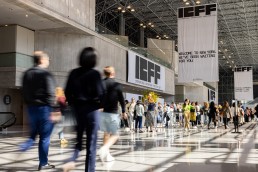
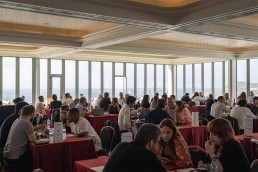
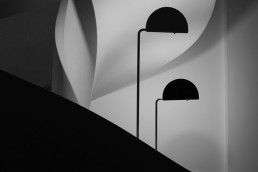
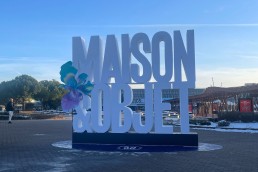
 www.opriginalhome.com
www.opriginalhome.com